Three home defeats in a row for the first time since 2004. Falling behind Barcelona in the win count between the sides for the first time in 87 years. Even though there was little to play for in this Clasico with La Liga title hopes slim to say the least, defeat to Barcelona really hurt for Real Madrid on Saturday evening.
It took just the one goal to decide the game, even though Real Madrid were out for revenge after being eliminated in the Copa del Rey semi-finals by a Barcelona thrashing at the Estadio Santiago Bernabeu on Wednesday. That strike came from Ivan Rakitic with a delicate chip over Thibaut Courtois just before the half-hour mark with what proved to be the winner in a 1-0 win.
Our tactical analysis will use statistics to identify what key points Real Madrid’s Santiago Solari can take from the game.
Lineups
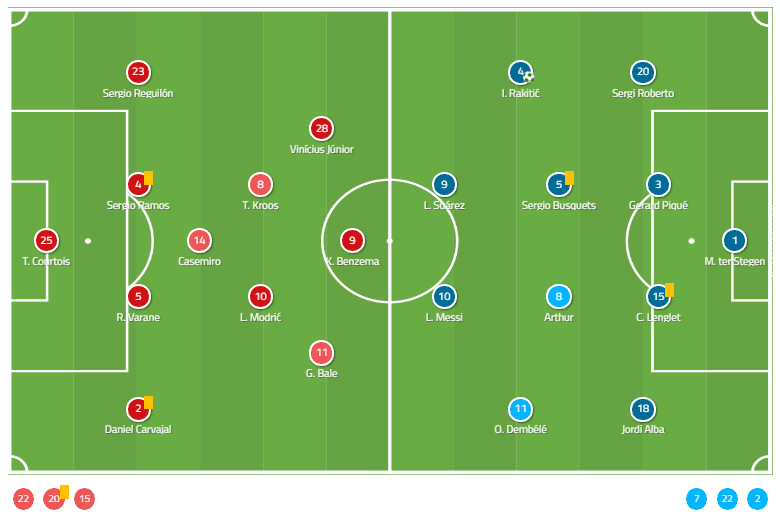
Real Madrid made two changes to their team from Wednesday’s defeat, recalling first choice goalkeeper Thibaut Courtois in Keylor Navas’ place as expected. Gareth Bale was also selected ahead of Lucas Vazquez in attack in a real statement of intent. Perhaps notably, Isco was also deployed from the bench in his longest league appearance since early January with the team going for the win.
Ernesto Valverde looked to regain control of midfield by bringing in Arthur to the Barcelona midfield, at the expense of Nelson Semedo, with Sergi Roberto dropping to right-back.
Reguilon left exposed
Where Barcelona presented a united and organised defensive set-up, Real Madrid looked a shambles. With Vinicius in his usual more advanced role, Barcelona looked to exploit it by building up numbers against the youngster Sergio Reguilon at left-back. Sergi Roberto often burst forward, forcing the young defender back. Sergio Ramos was given the choice of staying central to cover Luis Suarez and the often on-rushing Lionel Messi, or tracking the midfield runners.
The winning goal came through this approach. Rakitic’s smart one-two with Sergi Roberto saw him pull out Ramos as Barcelona broke, only to use Roberto to take Reguilon out of the equation. This effectively put Rakitic into a foot race with Ramos to earn a superb goalscoring chance as Casemiro trundled back, keeping an eye on the deep-lying Messi in behind him.
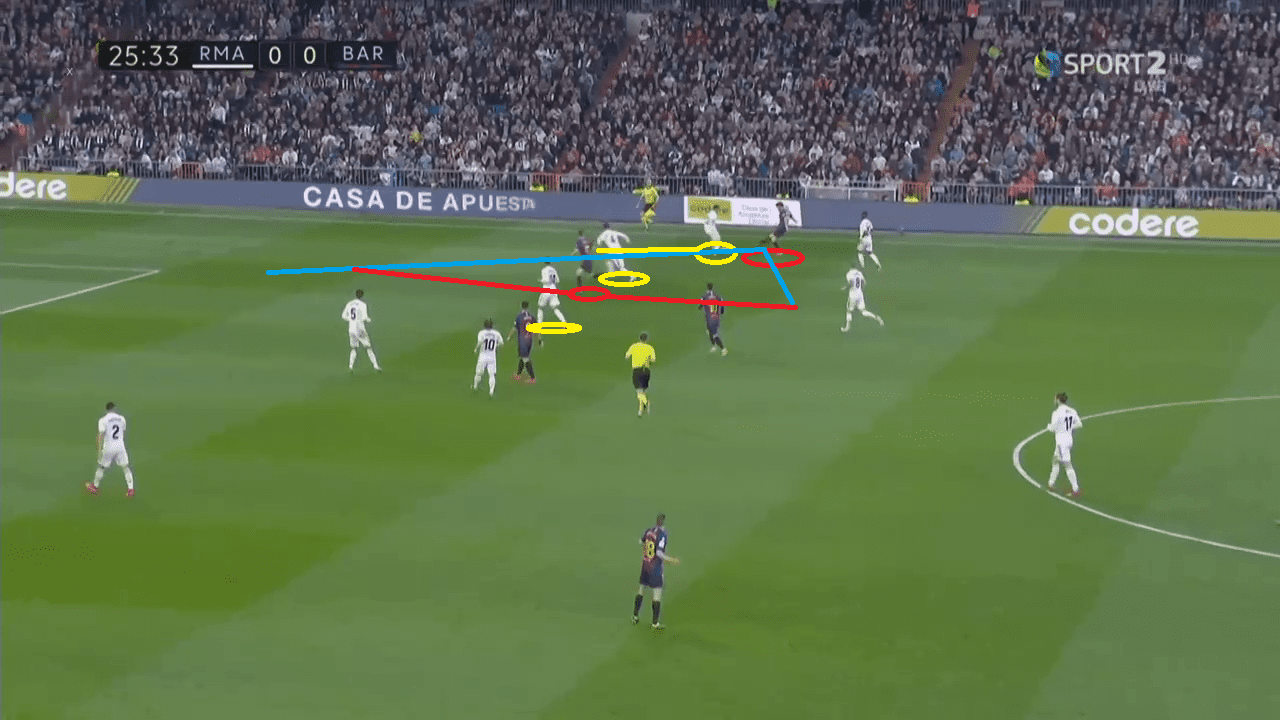
Raphael Varane was far too static in his defending, whilst the disorganisation of the Real Madrid midfield trio allowed Barcelona to outnumber Real Madrid time and time again down the flank. Allowing free reign to a team with players of the passing vision and range of Rakitic, Messi and Arthur Melo, and the pace of Ousmane Dembele, is always asking for trouble, as Real Madrid found out.
Gareth Bale: Wasted opportunity or misused?
Of all of the players to start at the Estadio Santiago Bernabeu, no-one had less possession of the ball than Gareth Bale. An increasingly isolated figure, he was left on the right flank in his less-preferred position, but managed a single speculative effort on goal and offered very little else to his team. He could have even been accused of hindering their efforts at times by his poor movement.
Not receiving the ball from his team-mates out on the right, he would drift deep and centrally to collect it. That allowed Jordi Alba more freedom to break forwards and also granted Ousmane Dembele more freedom, with Bale barely ever tracking the Frenchman and leaving Dani Carvajal with all the work to do.
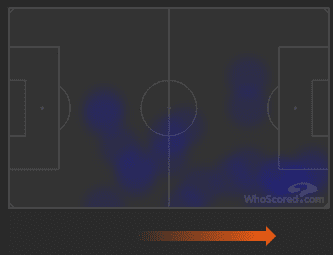
Some will argue that Bale will only find his best form again when given an opportunity in his preferred position on the left. To get that chance though, he has to justify it. Such anonymous displays in big games, like this one, do not convince Santiago Solari to gamble. The coach has shown that he isn’t afraid to do so, as proven by the introduction of Marco Asensio in his place and later Isco, but Bale is yet to show any sign of being the solution. As MARCA say that he went home before the final whistle had even been blown, he’s unlikely to win any friends on or off the field at this rate.
Casemiro’s unnatural midfield role
In a game where discipline would be essential to shutting out an excellent Barcelona attack, it was inexplicable to see the role that Casemiro played. The Brazilian left behind many of his usual defensive responsibilities, instead bombing forwards and at times even forming the most advanced point of the midfield triangle.
His freedom is perhaps best reflected by the number of crosses he made, far from a usual occurrence for the holding midfielder. This is reflected by the fact that he has never made more crosses in a single 90 minute game than in any other fixture dating back to when the statistics began in 2015.
That disrupted the balance, forcing an already struggling Toni Kroos into a deeper role with Luka Modric also struggling to break forward as he usually would. With all three men occupied with trying to apply pressure quickly and high to the likes of Arthur and Busquets, they quickly lost their shape and struggled to regain it when they won possession.
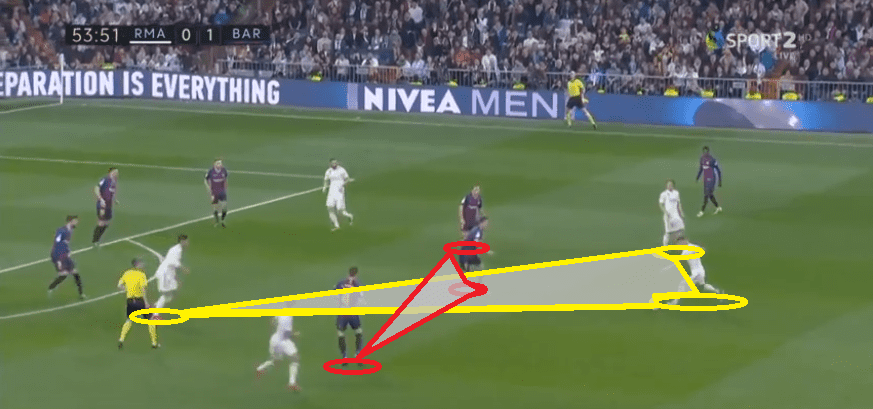
All that meant was that Barcelona’s narrow block could quickly sniff out chances and track runners, dividing the Real Madrid midfield from their attack with ease. When Barcelona sat back, the only option was to go wide, but even then they struggled. Attempting a mammoth 30 crosses, their third highest figure of 2019, they completed only 23% of them and found that Barcelona quickly cleared their lines and threatened on the counter-attack.
Vinicius under lock and key
On Wednesday Vinicius Junior wreaked havoc. The biggest threat for the hosts, Barcelona’s attempts to keep him quiet by doubling up with Sergi Roberto and Nelson Semedo were a dismal failure. On Saturday, Valverde immediately looked to correct that. Whenever the ball switched to the left flank, Ivan Rakitic would look to press Sergio Reguilon, with Sergio Busquets providing cover. Meanwhile Sergi Roberto would track Vinicius and Gerard Pique offered him cover in behind.
The tactic of overloading the flank meant that Real Madrid could find no way through. Where Vinicius failed to add the finishing touch on Wednesday, he could get nowhere near having any such chances this time around. By providing so much cover, Barcelona found the way to keep him quiet from the first minute until the last, halving his xG and keeping his touches in the danger area to the fringes of the box, playing speculative crosses in rather than cutting inside to shoot.
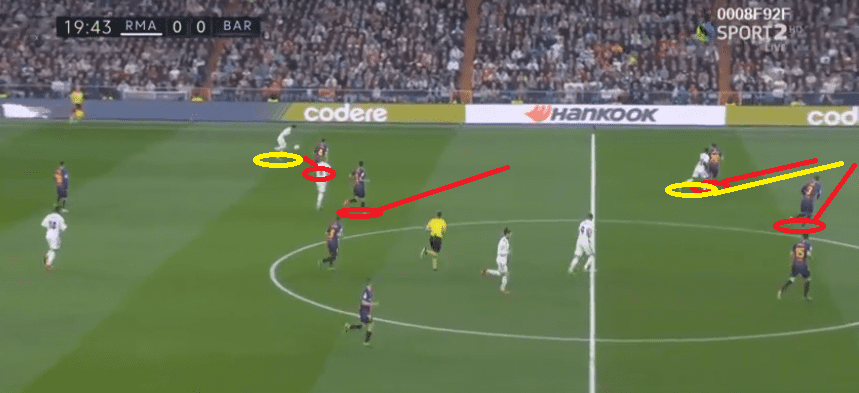
Where it left the Catalan side vulnerable was on the right, where a quick switch could have allowed Gareth Bale and Dani Carvajal forwards. However, they didn’t make the move and, as mentioned previously, Bale’s decision to continually drop deep prevented that from being a threatening option. Solari has never been known for his tactical prowess, and Valverde took complete advantage through this approach.
Conclusion
If Real Madrid could feel hard done by after the Copa del Rey semi-final, they could have no such complaints on Saturday night. Whilst they should have won by a clear distance on Wednesday, they can feel fortunate to have kept the score down to 0-1 on Saturday. Barcelona completely outsmarted Real Madrid tactically, learning from their mistakes on Wednesday to put them right and silence the threat of Vinicius Junior. With no other threat from Los Blancos, that was halfthe battle won for the visitors.
If you love tactical analysis, then you’ll love the digital magazines from totalfootballanalysis.com – a guaranteed 100+ pages of pure tactical analysis covering topics from the Premier League, Serie A, La Liga, Bundesliga and many, many more. Buy your copy of the February issue for just ₤4.99 here, or even better sign up for a ₤50 annual membership (12 monthly issues plus the annual review) right here.

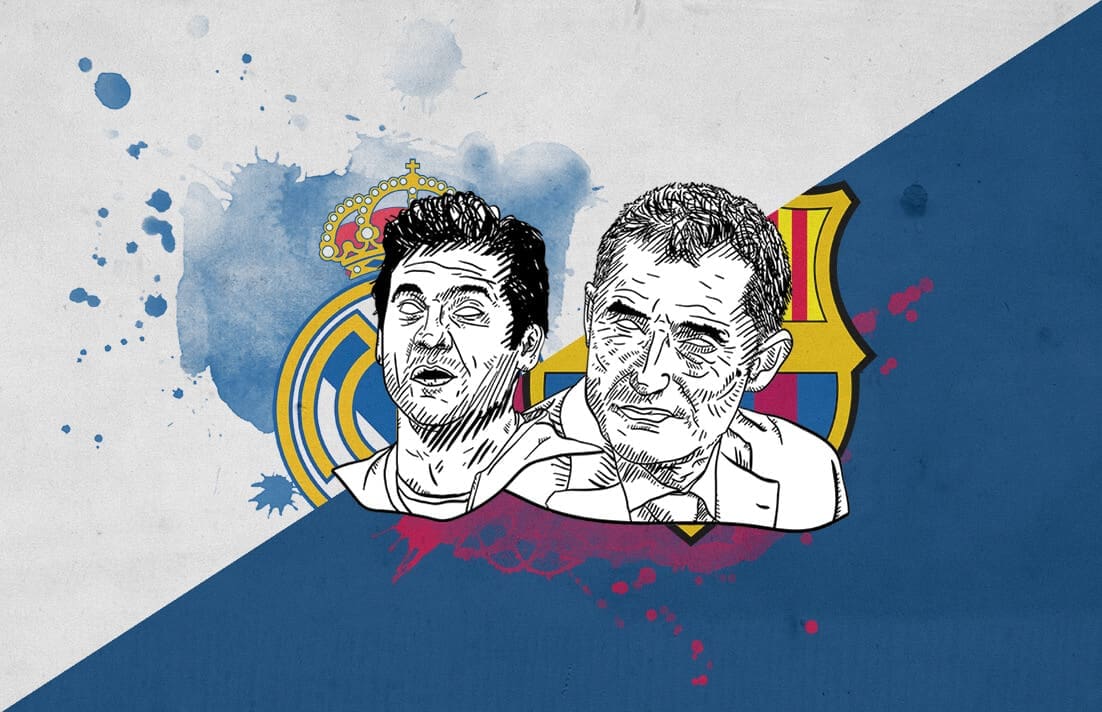



Comments